
The genus Argiope includes rather large spiders that often have a strikingly coloured abdomen. These spiders are distributed throughout the world. Most countries in tropical or temperate climates host one or more species that are similar in appearance. The etymology of Argiope is from a Latin word argentum meaning silver. The carapace of Argiope species is typically covered in silvery hairs, and when crawling in the sun, they reflect it in a way that gives them a metallic, white appearance.
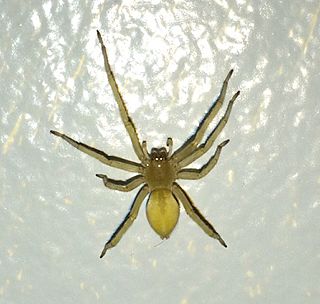
Cheiracanthium inclusum, alternately known as the black-footed yellow sac spider or the American yellow sac spider, was formerly classified as a true sac spider, and then placed in the family Miturgidae, but now belongs to family Cheiracanthiidae. It is a rather small pale yellow species that is indigenous to the Americas. It is often found living in the foliage of forests and gardens but also can inhabit human homes. Despite common beliefs of necrosis, Cheiracanthium bites cause only localized swelling. C. inclusum is closely related to Cheiracanthium mildei, an introduced species native to Europe which is similar in appearance and natural history and can also be found in North American homes.

Huntsman spiders, members of the family Sparassidae, are known by this name because of their speed and mode of hunting. They are also called giant crab spiders because of their size and appearance. Larger species sometimes are referred to as wood spiders, because of their preference for woody places. In southern Africa the genus Palystes are known as rain spiders or lizard-eating spiders. Commonly, they are confused with baboon spiders from the Mygalomorphae infraorder, which are not closely related.

Atypidae, also known as atypical tarantulas or purseweb spiders, is a spider family containing only three genera. They are accomplished ambush predators that spend most of their time in a sock-like, silken retreat on the ground from where they kill their prey.

The katipō is an endangered species of spider native to New Zealand. It is one of many species in the genus Latrodectus, such as the Australian redback, and the North American black widow. The species is venomous to humans, capable of delivering a potentially dangerous bite. It is a small to medium-sized spider, with the female having a round black or brown pea-sized body. Red katipō females, found in the South Island and the lower half of the North Island, are always black, and their abdomen has a distinctive red stripe bordered in white. In black katipō females, found in the upper half of the North Island, this stripe is absent, pale, yellow, or replaced with cream-coloured blotches. These two forms were previously thought to be separate species. The male is much smaller than the female and quite different in appearance: white with black stripes and red diamond-shaped markings. Katipō are mainly found living in sand dunes close to the seashore. They are found throughout most of coastal New Zealand except the far south and west. Katipō feed mainly on ground dwelling insects, caught in an irregular tangled web spun amongst dune plants or other debris.

Celaenia excavata, the bird dropping spider of Australia and New Zealand, derives its name from mimicking bird droppings to avoid predators, mainly birds. However, there are other species of spider that resemble bird droppings, for example species of Mastophora.
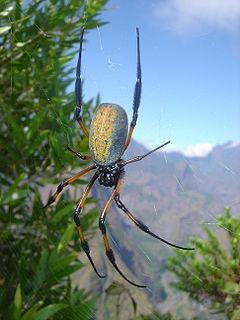
Trichonephila inaurata, synonym Nephila inaurata, commonly known as the red-legged golden orb-weaver spider or red-legged nephila, is a species of orb-weaver spider of the genus Trichonephila. It is native to southern and East Africa, as well as several islands of the western Indian Ocean.

The black house spider or common black spider is a common species of cribellate Australian spider, introduced to New Zealand and Japan. A closely related species, Badumna longinqua, the grey house spider, has a similar distribution, but has also been introduced to the Americas.

Argiope aurantia is a species of spider, commonly known as the yellow garden spider, black and yellow garden spider, golden garden spider, writing spider, zigzag spider, zipper spider, black and yellow argiope, corn spider, Steeler spider, or McKinley spider. The species was first described by Hippolyte Lucas in 1833. It is common to the contiguous United States, Hawaii, southern Canada, Mexico, and Central America. It has distinctive yellow and black markings on the abdomen and a mostly white cephalothorax. Its scientific Latin name translates to "gilded silver-face". The body length of males range from 5–9 mm (0.20–0.35 in); females range from 19–28 mm (0.75–1.10 in). These spiders may bite if disturbed or harassed, but the venom is harmless to non-allergic humans, roughly equivalent to a bumblebee sting in intensity.
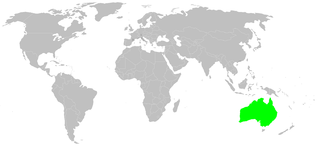
Phryganoporus candidus, also known as the foliage web spider, is a small, subsocial jumping spider endemic to Australia. On average, they are 6–10 mm long and are a mottled brown color, covered in silvery grey hair. They typically reside in arid and semi-arid locations, building their nests in various trees, bushes, and other plant-life. They have a mutualistic relationship with Acacia ligulata, and therefore prefer to build their nests in these trees.

Amaurobius ferox, sometimes known as the black lace-weaver, is a common nocturnal spider belonging to the family Amaurobiidae and genus Amaurobius. Its genus includes the permanently social species A. socialis, and three subsocial species, A. fenestralis, A. similis and A. ferox, all three of which have highly developed subsocial organizations.

Titanoeca quadriguttata is a species of spider in the family Titanoecidae. It is widespread in Europe, though absent from Great Britain, and is found in Austria, Belgium, Bulgaria, Corsica, Croatia, Czech Republic, France, Germany, Greece, Hungary, Italy, Liechtenstein, Moldova, Russia, Slovakia, Spain, Switzerland, the Netherlands, Ukraine.

Sidymella rubrosignata is a species of crab spiders found in Australia. It is a common spider, often seen on Dianella plants.

Arkys lancearius, the triangular spider, is a common Australian spider belonging to the family Arkyidae. It is an ambush hunter, commonly found resting on leaves and ferns or hanging from just a few threads of silk. The front two pairs of legs are large, suited for grabbing small insects, while the rear pairs of legs are much smaller.

Ariamnes colubrinus, known as the whip spider, is a common Australian spider belonging to the family Theridiidae. It is found in Victoria, New South Wales and Queensland.
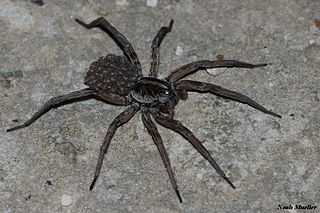
Hogna carolinensis, commonly known as the Carolina wolf spider, is found across North America. It is the largest of the wolf spiders in North America, typically measuring at 18–20 mm for males and 22–35 mm for females.

Tigrosa helluo is a species of spider belonging to the family Lycosidae, also known as wolf spiders. T. helluo was formerly known as Hogna helluo before differences between dorsal color patterns, habitat preferences, body structures, etc. were discovered. The species is native to the United States, Canada, and Mexico. It can be found across the eastern half of the United States, primarily in the Northeast and New England, and as far west as Nebraska and Kansas. T. helluo can be found in diverse habitats including woods, marshes, fields, and riparian areas. Typically, members of this species prefer to live in wetter areas as opposed to dry environments. Males tend to live for around a year and females will live for close to two years.
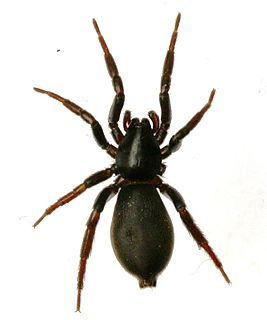
Zelotes subterraneus is a species of ground spider from the family Gnaphosidae which has a Palearctic distribution. it is the type species of the genus Zelotes. Its distribution may be somewhat masked by the difficulty of distinguishing this species from Zelotes apricorum and Zelotes latreillei.
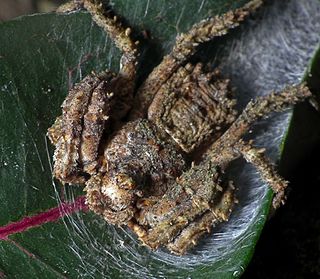
Stephanopis altifrons is a crab spider found in Australia. A cryptic species often hidden on bark of a tree. The body length of the female is up to 10 mm, the male 6 mm. The colour is usually brown, or shades of grey, sometimes black. The egg sac is 7.5 mm in diameter. Often placed in a crevice in tree bark; irregular in shape and camouflaged with debris. Eggs are off white in colour, 25 to 30 in number. The female rests with the eggs. The food of this spider appears to be other spiders. Recorded prey include spiders in the families Salticidae and Hersiliidae.

Euryopis splendens is a species of comb-footed spider in the family Theridiidae. The range of distribution is the south east of Australia. The spider lives under stones or bark.



















